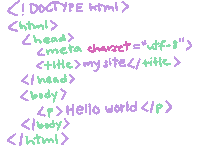
Building a website can be a fun and rewarding experience, but it’s important to have a solid foundation in HTML (Hypertext Markup Language) to get started. Here are some more detailed steps to help you build a website from scratch using HTML:

1. Learn the basics of HTML: HTML is a markup language used to create web pages. It’s important to have a good understanding of the basics before you start building your website. There are many resources available online to help you learn, including tutorials, videos, and courses. Some basic concepts you should learn include tags, attributes, and elements.

2. Plan your website: Before you start coding, it’s important to plan out your website. This includes thinking about the purpose of your site, what content you want to include, and how you want it to look. Creating a wireframe or mockup of your site can help you visualize your design and stay organized as you build your site.
3. Create your HTML document: Once you have a plan, it’s time to start coding. Open up a text editor, such as Notepad or Sublime Text, and create a new document. Save it as an HTML file with a .html extension. The structure of an HTML document includes the DOCTYPE declaration, the HTML tag, the head section, and the body section.

4. Add content: With your HTML document set up, you can start building your site by adding content. This can include text, images, videos, and links. Use HTML tags to structure your content and make it easy to read. Some common tags include headings, paragraphs, lists, images, and links.
5. Style your site with CSS: While HTML is used to structure your content, CSS (Cascading Style Sheets) is used to style it. CSS allows you to add colors, fonts, layout, and other design elements to your site. You can add a CSS file to your HTML document using the link tag, or you can use inline styles or internal styles. Some common CSS properties include font-family, color, background-color, padding, margin, and border.

6. Test and publish your site: Once your site is built, it’s important to test it to make sure everything works properly. You can test it on your own computer using a web browser, such as Chrome or Firefox, or you can use an online tool like Browser Stack to test it on different devices and browsers. Once you’ve tested your site and made any necessary changes, you can publish it online for the world to see. There are many web hosting services available, such as Bluehost, HostGator, and Site Ground.
With these more detailed steps, you can go from zero to hero and build a website with HTML. Remember to stay organized, keep learning, and have fun!
